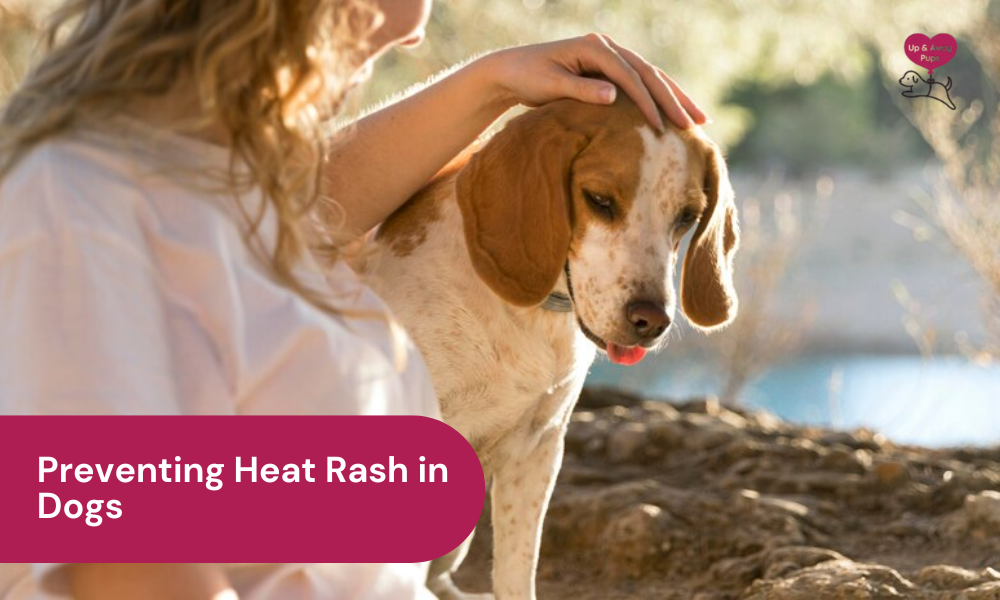Understanding Heat Rash in Dogs: Causes, Symptoms, and Treatment
Summers are synonymous with joy and enjoying the great outdoors. Long sunny days are perfect for beach days and exploring the mountains, and our furry friends love both the sea and long hikes. However, the sun can often be both a boon and a bane, causing heat rash in dogs. It falls upon us pet owners to keep our dogs free of these ailments that bother our furry friends to no end. In this blog post, we’ll take a look at what causes heat rash as well as how best to treat it.
What Causes Heat Rash In Dogs
Heat rash, also known as "prickly heat," is a skin condition that dogs suffer from when their skin becomes irritated due to excessive heat and moisture, as they are unable to cool down properly. It usually occurs during hot or humid summer months. It is quite similar to the heat rash humans experience.
However, the situation gets complicated when the realization hits that, unlike humans, dogs cannot sweat to regulate their body temperatures. Instead, they rely on other methods, such as panting, releasing heat through their paw pads and nose, and moving to cooler, shaded areas. Unfortunately, this is not always a successful or possible strategy in all environments.
Certain dog breeds, such as Bulldogs, that have low fur and skin that folds and wrinkles tend to be more susceptible to heat rash, as the folded skin is the perfect trap for heat and moisture, creating an ideal environment for heat rashes to develop.
Symptoms of Heat Rash in Dogs
Heat rash appears as redness, inflammation, and bumps on your dog's skin. These can, of course, be triggered by the environment, but excessive physical activity can also result in heat rash on a dog's belly, legs, or neck, as these are the most common areas where it is found. Other symptoms include:
1) Itching and Scratching: Heat rash in dogs can be very itchy and uncomfortable for them. If you notice your dog licking, scratching, or biting at the rash, it’s likely trying to relieve the irritation caused by the bumps.
2) Warm Skin: The skin around the rash might feel warmer to the touch, which suggests that your dog’s body is having difficulty cooling down.
3) Red, Raised Bumps and Inflammation: You might notice small bumps, redness, swelling, or hives, especially on your dog’s belly or legs. These could be early signs of heat rash in dogs.
4) Hair Loss: Dog belly heat rash or a rash in other parts of the body can often result in hair loss, and the constant biting and scratching of the area by the dog further exacerbates it.
As a pet parent, it is your obligation to educate yourself on dog heat rash symptoms to keep an active eye out for them, and seek medical assistance as soon as possible.
Heat Rash Remedies for Dogs
If your dog, unfortunately, suffers from heat rash, do not worry. Heat rash is a common condition in dogs and can be treated effectively by following the heat rash remedies for dogs mentioned below:
Don’t Let the Dog Out
When heat is the major culprit, it's a good idea to avoid letting your dog go outside for some time. This doesn’t mean confining them to a space but rather moving them to a cooler, shaded area, which is usually indoors. Provide them with fresh water to drink and gently wipe the rash with a damp, cool cloth to help lower their body temperature. A cool, not cold, bath using dog-friendly shampoo will also do wonders here.
Hydrocortisone Cream
If the rash is causing a lot of itching or inflammation, you can apply a mild hydrocortisone cream. However, before applying the cream, it is best to consult a vet beforehand to ensure it is indeed suitable for your dog.
Trim Them Furry Puppies
As adorable as the fur on Teacup Maltipoo and Miniature Sheepadoodle puppies looks, it is important to groom them properly so there is plenty of room for air circulation. It might not seem obvious, but proper grooming can do wonders in preventing heat rash in dogs. Grooming guides can help keep your dogs looking and feeling good.
Natural Remedies for Dog Heat Rash
Home remedies are alternatives that pet parents can use to help soothe the discomfort faced by their fur babies. Arguably, in comparison to traditional medicine, these do not have as much research backing them, but they have shown to somewhat help, at least temporarily, relieve the irritation and pain caused by rashes. The most common dog heat rash home remedies include:
1) Aloe Vera Application: Aloe vera is a natural healing agent that can reduce redness and draw heat away from the skin. Apply 100% natural aloe vera gel directly to the rash, avoiding bottled versions as they may contain alcohol or preservatives.

2) Cool Compress: As mentioned above, owners can apply a cool, damp cloth and gently press it to help cool down the affected area.
There are several more home remedies for dogs, like oatmeal baths or chamomile tea rinses but we would prefer more rigorous scientific research to be conducted on them before recommending them.
Seek Professional Treatment
If dog heat bumps do not disappear in a couple of days or if the symptoms worsen, it is paramount that you consult a veterinarian as soon as possible. They will perform the necessary tests and provide or recommend treatment as required. During the tests, they will also rule out the possibility of other skin diseases, bacterial infections, insect bites, allergies, etc., to ensure an accurate diagnosis.
Preventing Heat Rash in Dogs
While it isn’t possible to completely stop heat rash in dogs—they’re outdoorsy by nature—prevention is indeed possible. Many times, dogs can worsen a rash by licking, biting, and scratching it. It is best to put on a loose t-shirt or use a cone to prevent them from doing so. Puppies and dogs love playtime; it is both enriching and provides them with much-needed exercise. It is best to understand how much exercise a puppy needs and not overexert them, especially during warm weather conditions. Relegate outdoor playtime to nights or early mornings when the temperature is much more forgiving.
Conclusion
Heat rash in dogs is a common condition, especially during the summertime when humidity and heat are at their peak. If your dog does show symptoms of heat rash, step one is really not to panic and use the right techniques to provide them comfort. Keep them groomed for the weather, make sure they stay hydrated, and if the rash doesn’t show signs of improvement, you can always (and should) visit your vet. Don’t let the fear of rashes get in the way of you and your furry partner enjoying the great summer.


